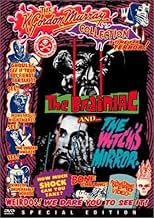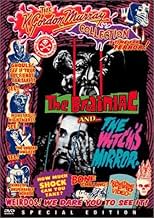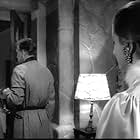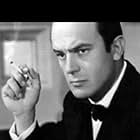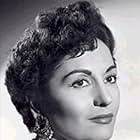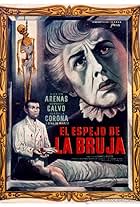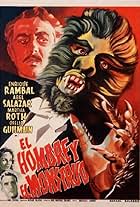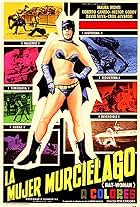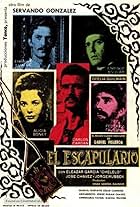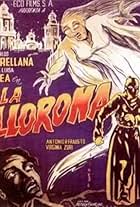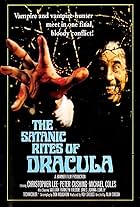IMDb RATING
5.0/10
1.4K
YOUR RATING
In 1661 Mexico, Baron Vitelius is executed for witchcraft. 300 years later, during a comet's return, he resurfaces as a brain-eating monster seeking revenge on the Inquisitors' descendants.In 1661 Mexico, Baron Vitelius is executed for witchcraft. 300 years later, during a comet's return, he resurfaces as a brain-eating monster seeking revenge on the Inquisitors' descendants.In 1661 Mexico, Baron Vitelius is executed for witchcraft. 300 years later, during a comet's return, he resurfaces as a brain-eating monster seeking revenge on the Inquisitors' descendants.
Germán Robles
- Indalecio Pantoja
- (as German Robles)
- …
Luis Aragón
- Prof. Saturnino Millán
- (as Luis Aragon)
Mauricio Garcés
- Médico forense
- (as Mauricio Garces)
- …
Ofelia Guilmáin
- Señora Meneses
- (as Ofelia Guilmain)
René Cardona
- Baltasar de Meneses
- (as Rene Cardona)
- …
Rubén Rojo
- Reynaldo Miranda
- (as Ruben Rojo)
- …
Magda Urvizu
- Ana Luisa del Vivar
- (as Magda Urbizu)
Rosa María Gallardo
- Victoria Contreras
- (as Rosa Ma. Gallardo)
Featured reviews
Following «Santo vs. the Vampire Women», another cult oddity came to Mexican cinemas in November 1962, surpassing the tale of wrestlers and female vampires in weirdness and kitsch value. Director Chano Urueta had previously released the classic «El espejo de la bruja» and then came «El barón del terror», probably the title for which he is most remembered among the horror genre fans for its bizarre concept. The story has a similar beginning as Mario Bava's «La maschera del demonio», in which Baron Vitelius d'Estera is sentenced to be burned alive by the Inquisition, accused of being a warlock and seducer. He curses his judges and 300 years later he returns to take revenge, as a hideous monster who eats people's brains. He kills the inquisitors' descendants, has enough cerebrum delicatessen at home to eat, but for no discernible reason Baron Vitelius also viciously kills innocent persons, among them pretty Ariadne Welter. Produced with a very low budget by Abel Salazar, who also took the title role, the money must have been spent in the top cast. The curious thing about «El barón del terror» is that everybody agrees that it is a trashy movie but none can deny the strange fascination it exerts.
After five relatively straight Mexican horror films - and despite being aware of the camp value of this one - I wasn't prepared for the laugh riot that THE BRAINIAC turned out to be...though, in retrospect, I guess I ought to have known judging from the brief snippets from it in the Eurotika documentary on Mexican horror films (available on the Region 2 Mondo Macabro DVD of EL VAMPIRO [1957])!
Its defenders suggest that the film was intended as a spoof; I may agree about that, given the fact that director Urueta had helmed one of the starkest examples of the genre I've seen so far - THE WITCH'S MIRROR (1960) - but that still doesn't explain why it should have been so goofy and nonsensical!! The film's credit sequence utilizes some of the sketches seen in the prologue of THE WITCH'S MIRROR(!), followed by a reasonably atmospheric sorcerer's trial and burning - though even these scenes don't escape hilarity due to the absurdly elongated list of accuses read before the court, the constantly grinning Klansmen-like judges and guards (on whom the Baron eventually plays a childish supernatural prank!), and the outrageous Pope-like costume the victim is made to wear for his execution. The astrology sequences are, again, long-winded yet impossibly naïve (with all the professor's theories, when his assistant looks into the telescope and tells him there's no trace of the comet, the former suggests that its trajectory may be entirely different to his calculations - but, then, it takes the leading lady a split-second to locate it!).
The special effects are unbelievably cheesy - especially the stationary comet; even more ridiculous is the monster's make-up with its large pulsating head, pointed nose, forked protruding tongue, long scruffy hair and hose-like fingers (the scene where he swipes the clothes of his first victim and leaves the dead man in his underwear is hilarious)! The Baron returns to Earth obviously to exact revenge on his judges' descendants, though God only knows why he needs to turn into a hideous, brain-draining creature in order to do so - I guess, the film wouldn't have become such a cult item otherwise! - but he occasionally adds new victims (such as the girl in a bar - which we're supposed to believe that it all happens without the other people noticing anything! - and a streetwalker, a scene accompanied by some particularly sleazy jazz music) which, if anything, serve to pad out the running-time (but still amounting to a brief 77 minutes) given the thinness of the plot line!
Anyway, the Baron invites all his intended victims to his Gothic mansion - explained by a quick reference to a jewel robbery in a police procedural scene - complete with cadaverous butler (how he knew where to find them, to say nothing of the fact that any of them would accept an invitation from a perfect stranger, I guess, never even crossed the screenwriters' minds!): here we witness another hilarious moment as the faces of the Inquisitors are dissolved onto those of their descendants, presumably for us to note the kinship between them, but this is only apparent in three of the cases - and that's because the same actors are used! So, he insinuates himself into each of their households and, turning into the Brainiac, kills them all - save for the last member, obviously the heroine; another rib-cracking moment occurs here when he excuses himself to his guests (who have come to him rather than the other way around) - sitting on the sofa merely feet away - so as to go to the cupboard where he keeps his supply of brains in a jar and nibble from it (actually, he does this a number of times, on each occasion complaining of an old ailment for which he needs a special medicine!).
Comic relief is provided by the clumsy assistant (with a penchant for American slang) of bald-headed cop David Silva; they finally catch up with the fiendish Baron and arrive at his house armed with flamethrowers (one of which refuses to work!) and they fry him - though he never actually catches fire and, when he finally dissolves into a skeleton, parts of his body are inconspicuously missing!! However, for me, these are the five moments in the film which make it a camp classic: Abel Salazar laughing at his accusers in the opening trial sequence, and then turning serious all of a sudden when the Inquisitors throw him a severe look; the rock falling from the sky announcing the arrival of The Brainiac; German Robles' paralyzed look while the monster is feeding on his voluptuous daughter; Rene Cardona's similar gaze - but, this time, he seems to be doing his damnedest to suppress laughter!; and the corpse hanging upside down (face underwater) in the bathtub.
The supplements, even more than the other Casanegra releases, impart the fun that the film so obviously provides; as with THE WITCH'S MIRROR, the Audio Commentary itself is a gas - even if, in that film's case, the subtext was discussed as well while it's not here...but that's because there isn't any!! As I had never watched the film before, I couldn't compare it to previous editions; suffice to say that that the transfer isn't problematic save for the very last scene - where, for a couple of minutes, there's the presence of some distracting extraneous flickering (that's how I can best describe it!) that, in all the reviews of the disc I've come across, is mentioned only by DVD Savant.
Its defenders suggest that the film was intended as a spoof; I may agree about that, given the fact that director Urueta had helmed one of the starkest examples of the genre I've seen so far - THE WITCH'S MIRROR (1960) - but that still doesn't explain why it should have been so goofy and nonsensical!! The film's credit sequence utilizes some of the sketches seen in the prologue of THE WITCH'S MIRROR(!), followed by a reasonably atmospheric sorcerer's trial and burning - though even these scenes don't escape hilarity due to the absurdly elongated list of accuses read before the court, the constantly grinning Klansmen-like judges and guards (on whom the Baron eventually plays a childish supernatural prank!), and the outrageous Pope-like costume the victim is made to wear for his execution. The astrology sequences are, again, long-winded yet impossibly naïve (with all the professor's theories, when his assistant looks into the telescope and tells him there's no trace of the comet, the former suggests that its trajectory may be entirely different to his calculations - but, then, it takes the leading lady a split-second to locate it!).
The special effects are unbelievably cheesy - especially the stationary comet; even more ridiculous is the monster's make-up with its large pulsating head, pointed nose, forked protruding tongue, long scruffy hair and hose-like fingers (the scene where he swipes the clothes of his first victim and leaves the dead man in his underwear is hilarious)! The Baron returns to Earth obviously to exact revenge on his judges' descendants, though God only knows why he needs to turn into a hideous, brain-draining creature in order to do so - I guess, the film wouldn't have become such a cult item otherwise! - but he occasionally adds new victims (such as the girl in a bar - which we're supposed to believe that it all happens without the other people noticing anything! - and a streetwalker, a scene accompanied by some particularly sleazy jazz music) which, if anything, serve to pad out the running-time (but still amounting to a brief 77 minutes) given the thinness of the plot line!
Anyway, the Baron invites all his intended victims to his Gothic mansion - explained by a quick reference to a jewel robbery in a police procedural scene - complete with cadaverous butler (how he knew where to find them, to say nothing of the fact that any of them would accept an invitation from a perfect stranger, I guess, never even crossed the screenwriters' minds!): here we witness another hilarious moment as the faces of the Inquisitors are dissolved onto those of their descendants, presumably for us to note the kinship between them, but this is only apparent in three of the cases - and that's because the same actors are used! So, he insinuates himself into each of their households and, turning into the Brainiac, kills them all - save for the last member, obviously the heroine; another rib-cracking moment occurs here when he excuses himself to his guests (who have come to him rather than the other way around) - sitting on the sofa merely feet away - so as to go to the cupboard where he keeps his supply of brains in a jar and nibble from it (actually, he does this a number of times, on each occasion complaining of an old ailment for which he needs a special medicine!).
Comic relief is provided by the clumsy assistant (with a penchant for American slang) of bald-headed cop David Silva; they finally catch up with the fiendish Baron and arrive at his house armed with flamethrowers (one of which refuses to work!) and they fry him - though he never actually catches fire and, when he finally dissolves into a skeleton, parts of his body are inconspicuously missing!! However, for me, these are the five moments in the film which make it a camp classic: Abel Salazar laughing at his accusers in the opening trial sequence, and then turning serious all of a sudden when the Inquisitors throw him a severe look; the rock falling from the sky announcing the arrival of The Brainiac; German Robles' paralyzed look while the monster is feeding on his voluptuous daughter; Rene Cardona's similar gaze - but, this time, he seems to be doing his damnedest to suppress laughter!; and the corpse hanging upside down (face underwater) in the bathtub.
The supplements, even more than the other Casanegra releases, impart the fun that the film so obviously provides; as with THE WITCH'S MIRROR, the Audio Commentary itself is a gas - even if, in that film's case, the subtext was discussed as well while it's not here...but that's because there isn't any!! As I had never watched the film before, I couldn't compare it to previous editions; suffice to say that that the transfer isn't problematic save for the very last scene - where, for a couple of minutes, there's the presence of some distracting extraneous flickering (that's how I can best describe it!) that, in all the reviews of the disc I've come across, is mentioned only by DVD Savant.
It turns out that all the word of mouth about the Mexican horror flick "The Brainiac" (1961) is absolutely correct: It IS one wild and loopy film experience! This picture tells the story of the necromancer Baron Vitelius Destera (played by the film's handsome producer, Abel Salazar), who is burned at the stake in 1661 by the Inquisition in Mexico City and swears vengeance on the descendants of his tormentors. Good to his word, the Baron falls to Earth in 1961 on a comet (the phoniest-looking comet ever shown on film, perhaps) to begin his homicidal agenda. Destera has the ability to transform himself into a giant-headed, pointy-nosed, fork-tongued monster, and his ability to hypnotize with a glance and bend others to his mental will makes his nefarious plans that much simpler. Oh...did I mention that the Baron uses his Gene Simmons-like tongue to suck his victims' brains out? Oh, man! Sounds pretty cool, right? Truth to tell, though, this film has been made on the cheap, with loads of ersatz-looking backdrops, lousy FX, and reams of unexplained happenings. Why, for example, does the Baron need to keep a stemmed dish of brains around for snacking purposes? How do the film's detectives ultimately crack the case of all these homicides? Why is fire able to harm the Baron in 1961 but not in 1661? Where DID that blasted comet disappear to? This movie has so many head-scratching moments, so many outrageous situations, so many admittedly cool murder scenes, such egregiously artificial backdrops and such strange humor (brain tacos, anyone?) that the net result is one of absolute lysergic surrealism. So yes, the movie is a hoot, and features a monster you won't soon forget. Unlike the Baron himself, the film is NOT a brain-drainer, but a genuinely exhilarating cult item. I, for one, was sufficiently impressed to check out director Chano Urueta's next effort, 1962's "The Witch's Mirror"...
The Brainiac was one of the many monster and horror films to appear on Chiller Theater in New York in the early 60's. I also remember the photo of the "Brainiac" with that elongated tongue on Famous Monster trading cards of the same era. Poor special effects and cheesy dubbed dialog, but what the heck, this is one of those flicks you stayed up to watch for scares as a little kid and laughs as you got older. The Mexican horror/monster movie of this era is truly a lost film genre. Fun stuff!
For once, the outrageous image displayed on the DVD-cover isn't an exaggeration, as the titular Terror-Baron for some reason really does occasionally mutate into a hideous creature with the long split tongue of a lizard, the big pointy ears of a bat and tiny trunks for hands! I don't know why the Mexican film crew opted for this peculiar monster-design, but it sure is original and a very welcome change from all the usual vampires, witches, werewolves and masked serial killers. The movie atmospherically opens in the year 1661, with the extended and relentless trial against Baron Vitelius d'Estera, who's condemned for sorcery, necromancy and a whole shopping list of other vile crimes against humanity. As a comet passes on the night of his execution, the Baron swears he'll reincarnate within 300 years and extract his bloody vengeance against the descendants of the Inquisitors who burned him alive at the stake. Punctually three centuries later, a comet falls onto earth and the Baron lives again. Introducing himself as a charming and eloquent man, he seeks contact with the kin of his executioners and ingeniously sucks the brains out of their skull whilst they're hypnotized. "Brainiac" doesn't play in the same quality league as some other contemporary Mexican horror films (like "Curse of the Crying Woman" and "The Black Pit of Dr. M"), but it's a tremendously entertaining and competently made black & white chiller. The film is fast-paced and obviously borrowing a lot of style-elements from fellow Gothic classics. The film is also stuffed with ludicrous twists and tacky special effects, yet for some reason the tone remains serious. Even when the screenplay reverts to dreadful clichés and stereotypes, the actors speak their lines straight faced and without blinking. The idea of vengeance against descendants isn't exactly groundbreaking either, but at least the film never gets dull or repetitive! Probably thanks to the incredibly cool-looking Baron, whose appearance is indescribably far-out! "Brainiac" is one bizarre horror film - albeit not THE most bizarre ever, like the tagline proudly announces and the hardcore cult fanatics among us definitely should purchase it.
Did you know
- TriviaThis movie was referred to in the Frank Zappa/Captain Beefheart song Debra Kadabra from the album Bongo Fury.
- GoofsAfter the Baron kills the professor and his daughter, he sets fire to their house. As they lay dead, their eyelids move.
- Alternate versionsIn the director's cut version, there's a scene where the Garces character ask to his reflection in the mirror: "Where's my god, where's my last love and my last reward for be crying to the night? Perhaps the legs of my diseased mother expels more energy than your love, God".
- ConnectionsEdited from The Witch's Mirror (1962)
- How long is The Brainiac?Powered by Alexa
Details
- Release date
- Country of origin
- Official site
- Language
- Also known as
- Le Baron de la Terreur
- Filming locations
- Estudios Churubusco - C. Atletas 2, Country Club Churubusco, Coyoacán, Mexico City, Distrito Federal, Mexico(Studio, as Churubusco-Azteca)
- Production company
- See more company credits at IMDbPro
- Runtime1 hour 17 minutes
- Color
- Aspect ratio
- 1.37 : 1
Contribute to this page
Suggest an edit or add missing content




